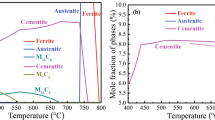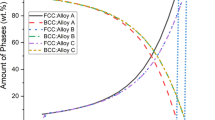Abstract
The potential enhancement of ballistic and mechanical properties from electroslag remelting has fostered an interest in mechanical property characterizations of electroslag remelted (ESR) steels for Army applications. Mechanical property data are presented for quenched and tempered ESR 4353 and ESR 4340 steels. Hardness decreases from 61.1 to 44.4 HRC as tempering temperature increases from 300 to 900° F for ESR 4353 steel. Correspondingly, fracture toughness (K IQ) increases from 23.4 ksi √in. to 89.7 ksi √in. The ESR 4353 steel exhibits Charpy impact energy values of 12.4 ft-1b for 400 and 450° F tempers, which decrease to 9.2 ft-lb for a 500° F temper as a result of tempered martensite embrittlement. The percentage of retained austenite decreases to approximately zero as tempering temperature increases to 500° F. Mechanical properties for similarly heat treated ESR 4340 steel are obtained from literature data. Results indicate that for a given tempering temperature or hardness, the ESR 4340 steel has greater Charpy impact energy and fracture toughness (K IQ).
Similar content being viewed by others
References
R.E. Rohtert,Ballistic Design Support Tests—A Tool for Helicopter Vulnerability Reduction. Presented at the AHS 31st Annual National Forum, Preprint No. 984, May 1975.
J. J. Prifti, D. Papetti, and W. Ricci,ESR Steel/Kevlar Armored Bucket Seat for Aircrew Protection. U.S. Army Materials Technology Laboratory, Published in JTCG/AS Conference on Design of Armor Systems Proceedings, June 1983, (Confidential Report).
C.F. Hickey, Jr., A.A. Anctil, and R. Chait,The Ballistic Performance of High Strength 4340 Steel Processed by Electroslag Remelting. Proceedings of Fracture Toughness of Wrought and Cast Steels, E. Fortner, ed., ASME MPC-13, 1980, pp. 219–229.
E. Plockinger,Electroslag Remelting—A Modern Tool in Metallurgy, Journal of the Iron and Steel Institute, August 1973.
D. Gibson, G. Boerman, and A. Gorum,High Strength Torsion Bar Development for Army Applications. FMC Corporation, Contract DAAG46-76-C-0074, Final Report, AMMRC TR 79-5, January 1979.
C.F. Hickey, Jr., and A.A. Ancil,Split Heat Mechanical Property Comparison of ESR and VAR 4340 Steel. U.S. Army Materials Technology Laboratory, AMMRC TR 83-27, May 1983.
C.F. Hickey, Jr., T.S. Thomas, and A.A. Anctil,Comparison of Ballistic Performance of a Split Heat of ESR and VAR 4340 Steel. U.S. Army Materials Technology Laboratory, AMMRC TR 85-20, July 1985.
A.A. Anctil, and F.J. Rudy,Engineering and True Stress-Strain Tensile Properties of High Strength ESR 4340 and 4350 Steels. U.S. Army Materials Technology Laboratory, AMMRC SP 75-9, November 1975.
A.A. Anctil,Mechanical Properties and Fractography of Electroslag Remelted 300M Steel. U.S. Army Materials Technology Laboratory, AMMRC TR 83-13, March 1983.
C.F. Hickey, Jr., of U.S. Army Materials Technology Laboratory, Letter Communications with FMC Corporation, 1983 and 1984.
E.C. Bain, and H.W. Paxton,Alloying Elements in Steel. American Society for Metals, Metals Park, Ohio, 2nd ed., 1961.
M.A. Grossman and E.C. Bain,Principles of Heat Treatment. American Society for Metals, Metals Park, Ohio, 5th ed., 1964.
D.L. Williamson, R.G. Shupmann, J.P. Materkowski, and G. Krauss,Determination of Small Amounts of Austenite and Carbide in a Hardened Medium Carbon Steel by Mossbauer Spectroscopy. Met. Trans. A, v. 10A, 1976, p. 379–382.
G. Dieter,Mechanical Metallurgy, McGraw-Hill, Inc., 2nd ed., 1976.
G.R. Speich,Tempered Ferrous Martensitic Structures. Metals Handbook, American Society for Metals, Metals Park, Ohio, v. 8, 8th ed.
R.W. Hertzberg,Deformation and Fracture Mechanics of Engineering Materials. John Wiley and Sons, New York, 2nd ed., 1983.
B. Chalmers,Physical Metallurgy. John Wiley and Sons, New York, 1959, p. 400.
T.B. Cox, and J.R. Low, Jr.,An Investigation of the Plastic Fracture of AISI 4340 and 18 Nickel-200 Grade Maraging Steels. Met. Trans., June 1974, pp. 1457–1470.
B.M. Kapadia, A.T. English, and W.A. Backofen,Influence of Mechanical Fibering on Brittle Fracture in Hot Rolled Steel Plate. ASM Transactions Quarterly, September 1962, pp. 389–398.
B. Mravic, and J.H. Smith,Development of Improved High-Strength Steels for Aircraft Structural Components. AFML-TR-71-213, October 1971.
W.J. Salesky and G. Thomas,Design of Medium-Carbon Steels for Wear Applications. 1981-ASME, Wear of Materials Conference Proceedings, San Francisco, CA, 30 March–1 April 1981, pp. 298–305.
W.E. Wood,Effect of Retained Austenite on Hydrogen Embrittlement of Steels. Oregon Graduate Center, ARO-13894.2-MS; AD-A078988, November 14, 1979, p. 18.
C.N. Sastry and W.E. Wood,On the Presence of Retained Austenite at the Prior Austenite Grain Boundaries of AISI 4340 Steel. Mater. Sci. Eng., October 1980, pp. 277–280.
K.W. Andrews,Empirical Formulae for the Calculation of Some Transformation Temperatures. JISI, v. 203, 1965, pp. 721–727.
D.P. Koistinen and R.E. Marburger,A General Equation Prescribing the Extent of the Austenite-Martensite transformation in Pure Iron-Carbon Alloys and Plain Carbon Steels. Acta. Met., v. 7, 1957, pp. 59–60.
Author information
Authors and Affiliations
Additional information
T.S. Thomas is formerly with the Metals Research Division
Rights and permissions
About this article
Cite this article
Thomas, T.S., Hickey, C.F. Mechanical property characterization of ESR 4353 steel with a comparison to ESR 4340 steel. J. Heat Treating 7, 49–55 (1989). https://doi.org/10.1007/BF02833187
Issue Date:
DOI: https://doi.org/10.1007/BF02833187




